8 Best eCommerce Marketing Tools to Double Your Sales in 2025
We've compiled the most effective eCommerce marketing tools that successful online stores use to automate their campaigns and boost conversions. Each tool is evaluated for ease of use, pricing, and integration capabilities with popular platforms like Shopify.


Being in eCommerce in 2025 means competing against millions of other stores. In fact, if you walk into any coffee shop, you'll hear someone talking about their ‘side hustle’ or ‘online business.’ Everyone's selling something online these days.
However, even with all that competition, you don't need to outspend Amazon to win.
All you need is a good mix of eCommerce marketing tools to automate or at least simplify some of your marketing.
Today, we're introducing you to your eCommerce marketing starter pack.
eCommerce marketing tools at a glance
| Tool | Price | Best for |
|---|---|---|
| Cropink | Free plan available $39/month | Catalog ad automation at scale |
| Feedink | Free plan available $99/month | Product feed optimization for ad platforms |
| Omnisend | Free plan available $11.20/month | Abandoned cart recovery and email automation |
| ROI Hunter | 1-5% of ad spend | Product performance analysis and budget allocation |
| Google Analytics | Free plan available $50,000/year (enterprise) | Traffic source analysis and user behavior tracking |
| Hotjar | Free plan available $39/month | User experience optimization and conversion insights |
| Shopify | $39/month | eCommerce store hosting and management |
| ReferralCandy | $79/month + 3.5% of referral sales | Customer referral program management |
1. Cropink for ad automation
Creating catalog ads at scale is one of those jobs that sounds simple until you actually try to do it.
You start with a product feed full of SKUs, then realize you need to create hundreds of ads that are not only visually appealing but also accurate, on-brand, and ready to go live across different channels.
Doing that manually, especially if your catalog is always changing, is exhausting.
Cropink can help you skip that manual process.
Using Cropink, you can upload your product data, either as a file or via a feed URL, and Cropink starts generating catalog ads automatically.
If you want something quick, you can use one of the free, fully customizable templates. If you have a designer on the team, there's a Figma plugin that gives you full creative control.
You can add reviews, highlight discounts, call out features, and apply customized backgrounds to your catalog ads and style to match your brand.
The best part is, once it's set up, the system updates itself. If your feed changes, your ads reflect those changes automatically.
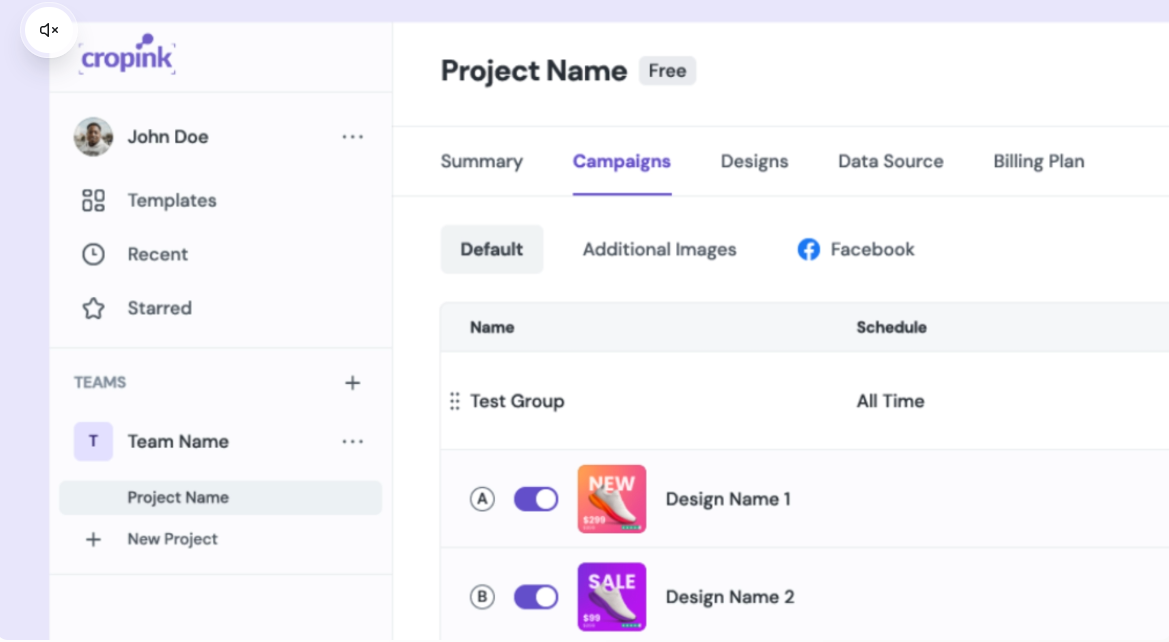
Key features
- Sync your catalog via Shopify, Meta, or XML
- Use a brand kit to keep every ad visually consistent
- Automatically update creatives when your product feed changes
- Highlight pricing, reviews, and other dynamic data using flexible rules
- Customize layouts with your own fonts, backgrounds, and visual styles
- Share templates and assets across teams
- Schedule campaigns in advance so you're not scrambling last minute
Pricing
- Free plan for your first 25 products
- Paid plans start at $39/month for 500 products
- Campaign scheduler for automated publishing
- Multi-platform support
- Generous free plan with full features
- Seamless Figma integration for advanced users
Doesn’t support product-level video ads yet
2. Feedink to simplify catalog management
If you’ve ever tried submitting your catalog to Google, Meta, TikTok, or Criteo, you already know how picky each platform can be. Now, if you were to honor these standards manually, you'd take forever to get it right.
Fortunately, Feedink is one of the most reliable product feed management platforms available today.
This tool takes your product file, whether that’s XML, CSV, or via an API, and turns it into a structured, channel-ready feed.
You can then submit your catalog to hundreds of destinations, including shopping engines, affiliate networks, marketplaces, and price comparison sites.
You don't have to be the most technical person to make changes to Feedink. The platform uses an easy, rule-based system that lets you tweak your product data without touching your source file. If a product is missing a description, has the wrong image, or needs a price adjustment, you can fix it right from the dashboard.
If something goes wrong, Feedink checks for major errors like large product drops and blocks those updates to protect your campaigns.
Should you invest in such a tool?
100%. Research shows that advertisers with optimized data feeds get 34% more clicks on their shopping ads.
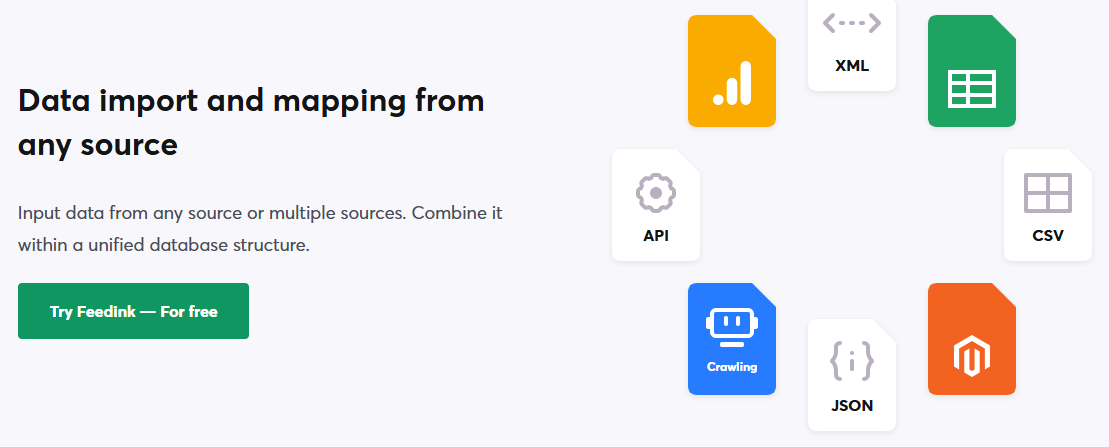
Key features
- Import product data via XML, CSV, API, or automatic crawling
- Modify and optimize data using over 100 types of rules
- Built-in protection against feed errors and large product drops
- Real-time preview before you push changes live
- Google Analytics integration for campaign performance insights
- Email alerts for major updates or problems
- Historical logs and downloadable data exports
- Supports Google, Meta, TikTok, Criteo, Snapchat, and 100s of other channels and markets
Pricing
- Free plan available
- Paid plans start at $99/month
- You can map data from any source
- An intuitive and easy-to-use UI
- Works with all major advertising platforms
- Built-in safety features to prevent mistakes
- Free for 25 products
Doesn’t offer catalog ad generation
3. Omnisend for AI-powered email marketing
Omnisend gives you everything you need to automate welcome emails, abandoned cart recovery, and post-purchase follow-ups.
This AI-powered tool comes with a ready-to-use library of email templates and automation workflows. You can create campaigns using a simple drag-and-drop builder and personalize them with customer data you already have.
You also get unlimited segments that update in real time. In short, you can group your audience by shopping behavior, email engagement, or campaign history, and always send the right message at the right time.
Omnisend isn’t limited to email either. It also supports SMS, web push notifications, Facebook, and Google retargeting sync.
Best of all, it connects easily with most eCommerce platforms, including Shopify, WooCommerce, Wix, Shoplazza, and WordPress.
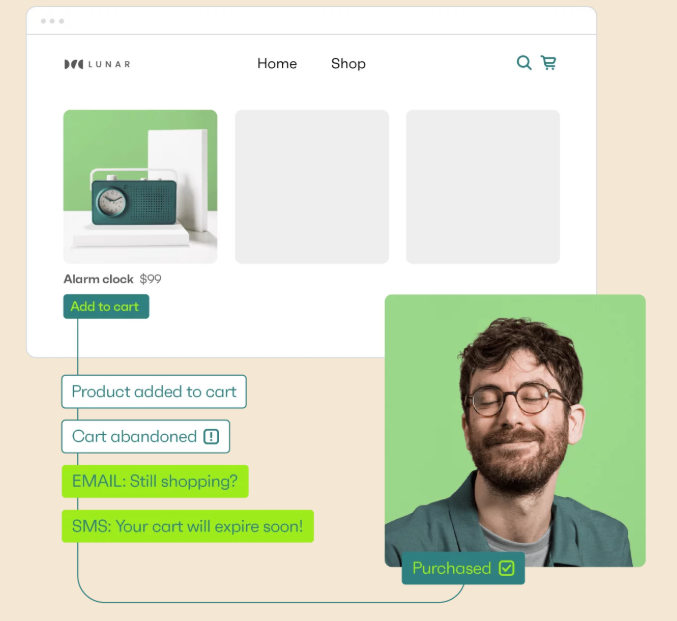
Key features
- Pre-built email templates and automation workflows
- Drag-and-drop email builder
- Real-time audience segmentation
- Customizable, TCPA and GDPR-compliant forms
- Dynamic discount codes and product recommendations
- Sales dashboard with campaign and automation reports
- Omnichannel features, including SMS, web push, and retargeting sync
Pricing
- Free plan for up to 250 contacts
- Paid plans start at $11.20/month
- Simple to use, even for beginners
- Responsive customer support
- Covers both email and SMS on one platform
- Works with most eCommerce platforms
- Advanced reports aren’t updated in real time
- No support for custom domains on landing pages
4. ROI Hunter to find winning products
Roi Hunter shows you data-backed insights about which products are worth promoting.
This product performance software connects your product catalog with data from your ad platforms, analytics tools, and custom sources. It then gives you one place to review how each SKU is performing across Meta, Google, and more.
You can see which products are driving conversions, which ones are dead stock, and which are draining budget without delivering sales. ROI Hunter groups them automatically into categories like bestsellers, underperformers, new arrivals, and fragmented stock.
You can also make dynamic product ads using static images.
However, if you want better creative control and more of a plug-and-play tool, consider these ROI Hunter alternatives.
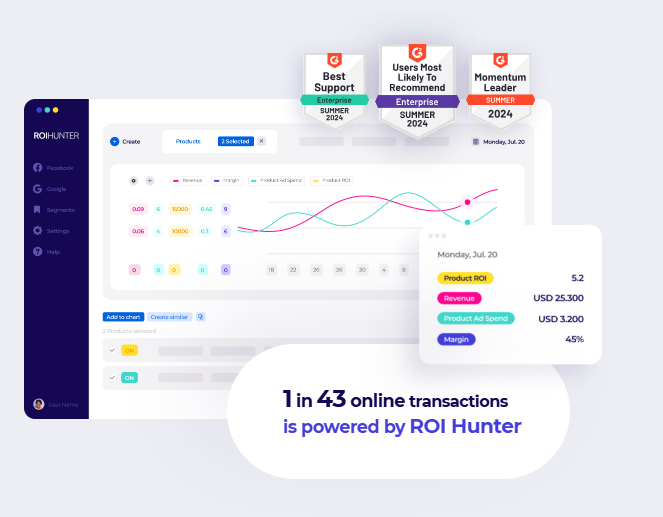
Key features
- Merge feed-level data with Google Analytics and campaign performance
- Product Performance Management (PPM) features
- Categorize products by real-time performance
- Build product-based ad creatives from static images
Pricing
- No free trial
- Pricing ranges from 1 to 5% of your ad spend
- Makes it easy to spot high-performing and low-performing products
- Combines campaign and product data in one dashboard
- Personalized customer support
- Takes more time to set up and connect data sources
- Not ideal for small brands or beginners
- Some users report freezing issues on the platform
5. Google Analytics to review traffic sources and user behavior
You’ve launched your store, traffic is coming in, and orders are trickling through, but do you know exactly where your customers are coming from, and what they are doing before they buy or leave?
Google Analytics helps you figure that out.
It gives you a clear view of how people find your store, what pages they visit, how long they stay, and where they drop off.
You can track performance across traffic sources like search, social, email, and referrals, and understand how each one contributes to your sales.
It also helps you measure key actions like product views, add-to-carts, and completed purchases.
If you’re running ads, you can connect your account with Google Ads to measure return on ad spend (ROAS) and click-through rates (CTRs).
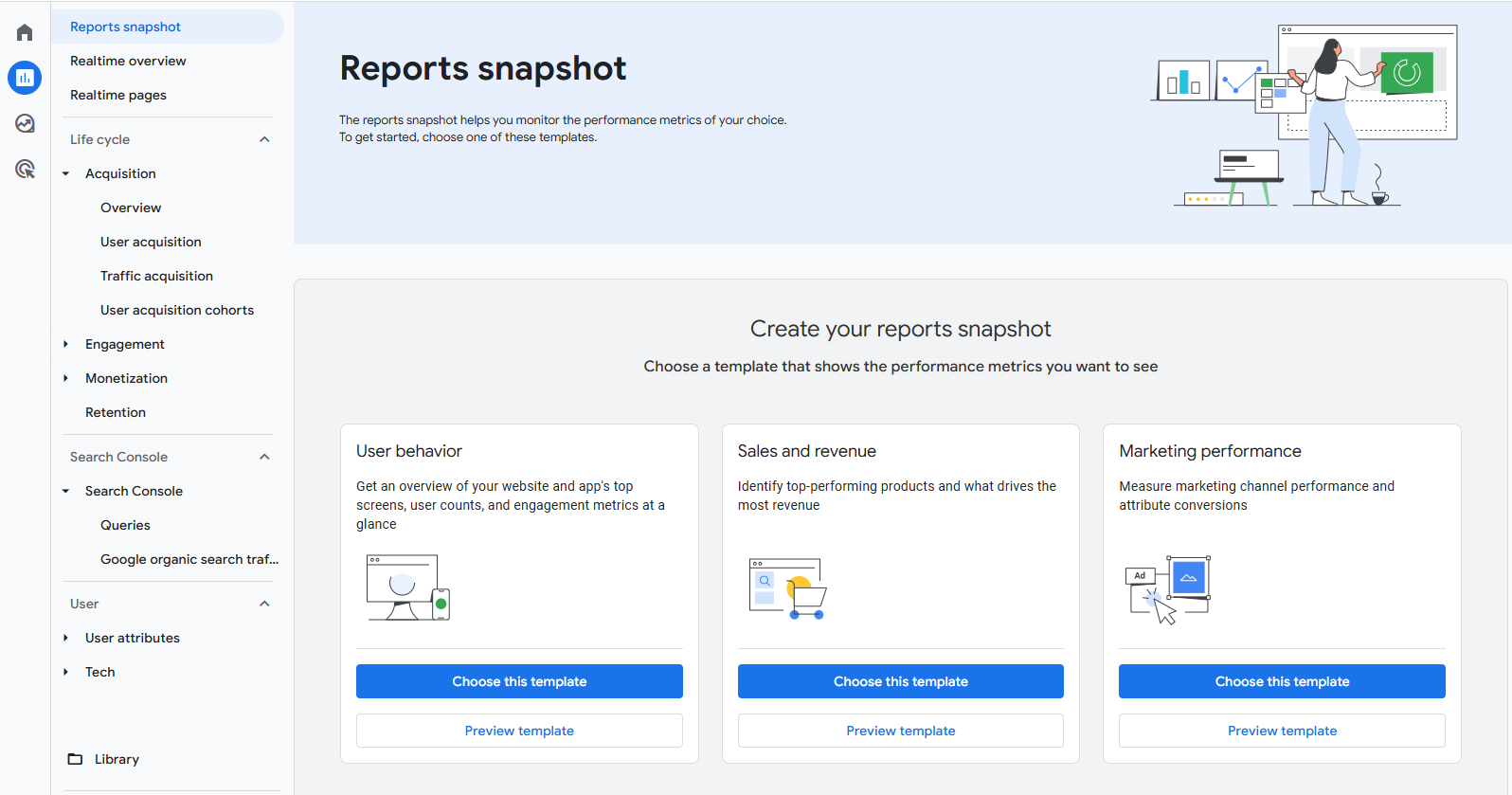
Key features
- Track where your website traffic is coming from
- See which products or pages users visit most often
- Track how long visitors stay on your site
- Measure conversions like purchases, sign-ups, or button clicks
- View user behavior flow to understand how visitors move through your site
- Compare performance across different devices like mobile, tablet, and desktop
- Set up goals to track actions such as completed purchases or checkout initiations
- Segment your audience by location, device, or traffic source for more in-depth insights
- Integrate with Google Ads to measure campaign performance
Pricing
- Free generous plan
- GA360 starts at around $50,000 per year for enterprise brands
- Free and widely used
- Customizable to match your tracking needs
- Integrates with most eCommerce platforms and marketing tools
- Requires technical expertise to set up and track eCommerce data
- Unintuitive UI
- Privacy laws and cookie opt-outs can limit your data
6. Hotjar to understand user behavior
Google Analytics tells you what happened on your site, but Hotjar shows you why it happened.
Hotjar gives you visual feedback on how people are interacting with your site via session recordings and heatmaps.
You can watch session recordings to see what they click, how far they scroll, and where they get stuck. If a user abandons their cart right after opening the shipping page, you’ll see it happen.
Heatmaps, on the other hand, help you understand what’s drawing attention and what’s being missed entirely. This data is handy when tweaking layouts, moving CTAs, or improving site usability.
Hotjar also lets you run surveys to ask users directly what's confusing them or what they need to complete their purchase.
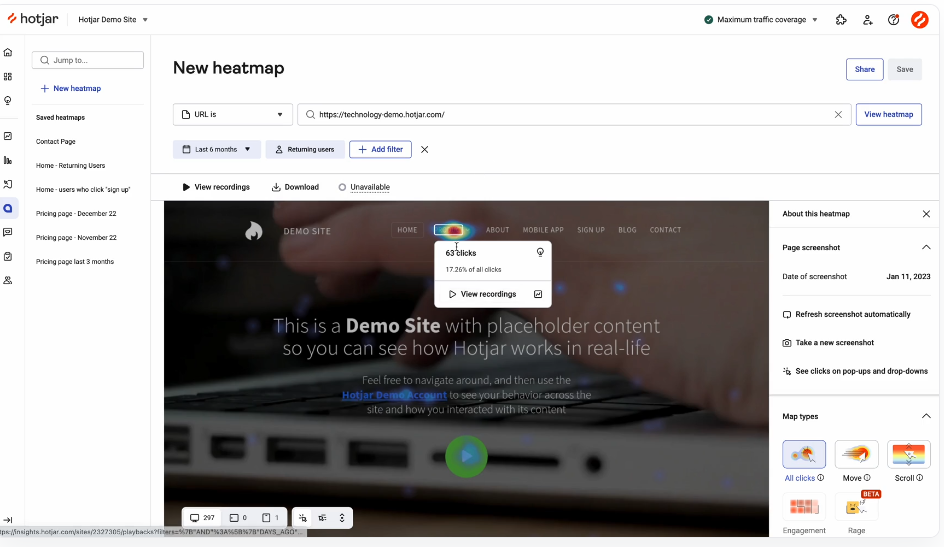
Key features
- Watch screen recordings of how users navigate your site
- Use heatmaps to see where people click and spend the most time
- Collect feedback directly from users through on-site surveys and suggestion boxes
- Analyze where users drop off in multi-step flows like checkout
- Trigger surveys based on user behavior, like exit intent or time spent
- Segment recordings by device, country, or behavior to spot patterns
- Integrate with tools like Google Analytics, HubSpot, and Slack
- Invite unlimited team members to collaborate and view insights
Pricing
- Free plan for up to 35 daily sessions
- Paid plans start at $39/month for 100 sessions
- Visibility into how users experience your site
- Useful for identifying friction and broken elements
- Fast setup and no coding needed
- Combines quantitative and qualitative insights
- The free plan is limited for high-traffic stores
- It’s not a replacement for full-scale analytics tools
7. Shopify to host your eCommerce store
Our working theory was that you had already set up your eCommerce store and were looking for additional tools to make it better.
But if you haven't, Shopify is probably the most well-known and easiest platform to host your store on.
Because it's super popular (2,513,618 live stores as of 2025), virtually any tool you want to use will probably integrate with Shopify.
The best thing about Shopify is how it can accommodate a little craft online eCommerce store all the way up to a large store like Gymshark with $500M+ sales annually.
It comes with themes to help you design quickly, and even AI integrations to customize these themes. Shopify also provides a built-in checkout.
However, it's not the only platform to host your store. You can also use any one of these Shopify alternatives if you want to explore other options.
However, if you're already on Shopify, you might want to check out some of the best Shopify stores for inspiration or learn how to get customers on Shopify with one of these Shopify advertising strategies.

Key features
- Build and customize an online store with drag-and-drop templates
- Create discount codes and automatic promotions to boost sales
- Track orders, inventory, and customer data in one centralized dashboard
- Set up email marketing campaigns directly from your Shopify dashboard
- Integrate with Facebook, Instagram, TikTok, and Google for multichannel selling
- Use built-in analytics to monitor traffic, sales trends, and customer behavior
- Collect and manage customer reviews and product ratings
- Access to thousands of apps to extend your marketing capabilities
Pricing
- $1/month for the first 3 months on select plans
- Paid plans start at $39/month. For a full breakdown, see our Shopify pricing guide
- Easy to set up and launch, even with no coding experience
- Responsive templates that look great on mobile
- Handles everything from payments to shipping
- Huge ecosystem of apps and third-party integrations
- 24/7 customer support
- Extra fees if you use payment gateways like PayPal or Stripe
- CMS is limited if you want to publish a blog or web content
- Backend changes often require developer help or knowledge of Liquid (Shopify's template language)
8. ReferralCandy to simplify referral marketing management
Some of your happiest customers would gladly refer their friends if you gave them a nudge. This is exactly what ReferralCandy helps you do.
You set the reward, such as a discount, store credit, cash, or something custom, and ReferralCandy takes care of the tracking, attribution, and delivery.
ReferralCandy can plug into your Shopify store and connect with platforms like Meta, Google Analytics, and WordPress. You can embed referral links into customer accounts or trigger them after checkout with a simple widget.
The latest referral marketing statistics show that referred customers bring in 25% more profit and are 18% more loyal than regular ones. So this is one of those tools that can actually pay for itself.
ReferralCandy also offers fraud protection to block self-referrals and shady orders, which is one less thing to worry about.
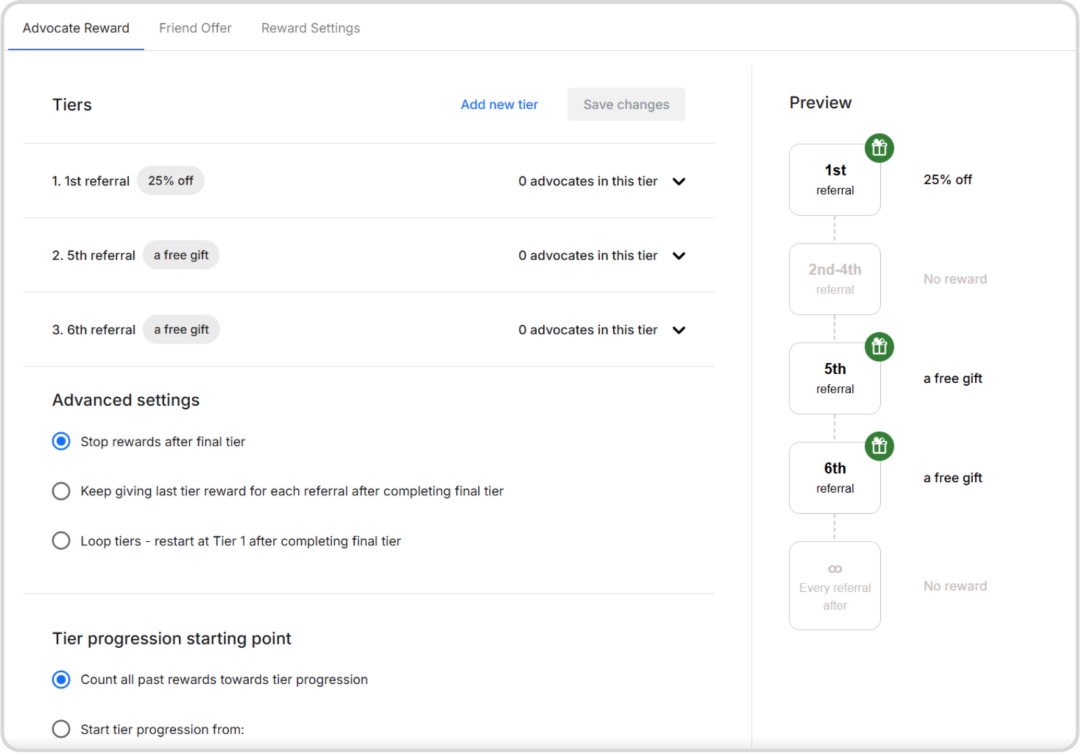
Key features
- Reward customers with discounts, credit, or cash
- Track referrals in real time
- Auto-detect and block fraud or abuse
- Embed referral links or show post-purchase widgets
- Works with Shopify, Meta, WordPress, and Google Analytics
Pricing
- 14-day free trial
- $79/month plus 3.5% of referral sales
- Easy to manage once the system is up
- Direct Shopify integration
- Insightful performance dashboard
- Friendly and responsive support
- Users report glitches every now and then
- A bit complicated to set up initially
Tips to choose the best eCommerce marketing tools
Before adding anything to your stack, think about what you're actually trying to solve. Is it traffic? Conversions? Retention? After that, assess these #3 more things:
- Consider your team size
Some tools, such as ROI Hunter, are built for bigger teams with dedicated analysts. If you are a small team, such a tool will give you more work, not help you scale. In the event that you’re a small team or a one-man show, go for plug-and-play tools like Cropink, Omnisend, and Shopify since setting them up is quite simple.
- Match tools to your current growth stage
If you’re building momentum through ads, go for catalog automation and product insights with tools like Cropink or ROI Hunter. For stores with high traffic but low conversions, Hotjar can show what’s going wrong on key pages.
- Look for tools that work well with your store setup
Most tools in this guide integrate directly with Shopify, Google Analytics, or Meta. Choosing such tools that connect easily will save you hours of setup and avoid workflow disruptions.
Summary and recommendation
You don’t need all #8 eCommerce marketing tools to double your sales. What you need are a few tools that will help you get the basics right.
Start by setting up Google Analytics properly so you can measure what’s working. Then build on that foundation with Cropink and Feedink to run efficient product ads without doing everything manually.
Once that’s in place, use Omnisend to recover abandoned carts and send timely, automated follow-ups. As your store grows, you can layer in more advanced tools like ROI Hunter to dig more in-depth into product performance and budget allocation.
If you're still unsure where to begin, take a step back and ask yourself which tools will move the needle and which ones will only add complexity with no clear ROI.
FAQs
If you're running a lean store, start with Google Analytics for tracking, Cropink for ad automation, and Omnisend for email and SMS. These tools are affordable, easy to use, and give you good returns without overhauling your workflow.
Concentrate on tools that either save you time or help you make more sales. If a tool doesn’t clearly impact your traffic, conversions, or retention, it’s probably not worth the spend, no matter how many features it offers.
Every tool mentioned in this guide integrates with Shopify, either natively or through apps and connectors.

Damaris is a Digital Marketing Specialist who writes about digital marketing and performance marketing. At Cropink, she creates data-driven content to help businesses run better ad campaigns for better performance and ROI.

Leszek is the Digital Growth Manager at Feedink & Cropink, specializing in organic growth for eCommerce and SaaS companies. His background includes roles at Poland's largest accommodation portal and FT1000 companies, with his work featured in Forbes, Inc., Business Insider, Fast Company, Entrepreneur, BBC, and TechRepublic.
Related Articles
Looking for Shopify store inspiration? Explore 30+ of the best Shopify stores in 2026—from fashion and beauty to tech and home. See what makes them stand out.

Shopify powers 4.8M+ stores in 2025—but what’s the real cost? From $5 starter plans to $399 advanced options (plus hidden fees), this no-fluff guide breaks down everything you need to know before you launch.

Struggling to get traffic on Shopify? You’re not alone—over 2.1M merchants are fighting for attention. Discover the 2025 ad strategies top sellers use to turn clicks into customers without burning cash.

Getting people to find your Shopify store is one thing. Getting them to buy is a whole other game. These 10 strategies help you build trust, attract the right customers, and turn traffic into sales without gimmicks.

Social commerce is reshaping how we shop—set to become a $1 trillion market by 2028. Discover which platforms are leading the charge and how tools like Cropink can help you sell directly inside social apps.

Most successful Shopify stores have one thing in common: they run ads. When it comes to advertising on Shopify, you have two main options: Shopify's native Shop campaigns or running Meta ads through your own accounts. This article breaks down when to use each method and exactly how to get started with whichever option fits your needs.

Facebook can become a full-on storefront if you know how to set it up right. This guide walks you through the necessary steps to create a Facebook Shop, get approved, and tweak it so shoppers trust you enough to hit buy.

eCommerce fraud is surging—global losses hit $44.3B in 2024 and could soar to $107B by 2029. Discover the latest fraud stats, rising threats like AI scams, and how to protect your online business in 2025.

Shopify Collective helps U.S. and Canadian retailers earn 20–40% profit without holding inventory. As ecommerce drives over a third of B2B revenue and global sales near $32.8T by 2026, learn how to scale your catalog and boost growth inside Shopify’s trusted ecosystem.

Shopify powers over 2.5M live stores in 2025—but that's after a massive 45.7% drop from last year. This data-packed breakdown reveals where the market is shrinking, who's growing (hello India and France), and why most of Shopify's 7.2M stores don’t survive.

Discover the top 12 Shopify alternatives in 2025! From free plans for small businesses to enterprise-level customization, find the perfect platform—whether you're a creative brand, digital creator, or global powerhouse.

How does Shopify work? In 2025, it powers 2.5M+ live stores and supports global sellers with tools for building, managing, and growing an online business. This guide shows how Shopify works, from setup to checkout, with stats, tips, and zero coding required.

How Can Cropink Help?
Start with Cropink is easy and free
No credit card required